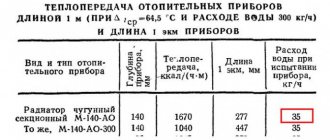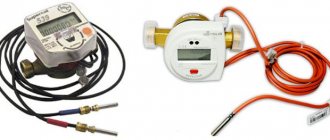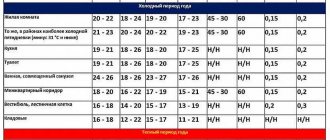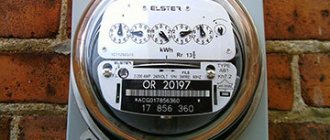What is Gcal
The cost of heating is important for residents of high-rise buildings with a central coolant supply.
The concept gigacalorie means a unit of measurement of thermal energy in heating. This energy within the room is transferred by convection from batteries to objects and radiated into the air. A calorie is the amount of energy required to warm 1 g of water by 1 degree at atmospheric pressure.
To calculate thermal energy, another unit is used - Gcal, equal to 1 billion calories. On average, heat consumption per 1 sq. m in Gcal in the Russian Federation is 0.9342 Gcal/month. If we convert the indicator into other values, 1 Gcal will be equal to:
- 1162.2 kW/h;
- heating 1 thousand tons of water to +1 degree.
The value was approved in 1995.
Features of Gcal for residential high-rise buildings
The thermostat allows you to control the flow of coolant and temperature.
If a multi-apartment building is not equipped with a common building or individual meter, thermal energy is calculated based on the area of the premises. When there is a metering device, horizontal or sequential route routing, residents independently determine the amount of thermal energy. For this we use:
- Throttling of radiators. When traffic is limited, the temperature decreases and energy consumption decreases.
- A general thermostat is installed on the return line. Coolant consumption depends on the temperature in the apartment. At low flow rates the temperature is higher, at high flow rates it is lower.
An apartment in a new building is mainly equipped with an individual meter.
Specifics of Gcal for a private home
The cheapest fuel in terms of gigacalories are pellets.
The material spent on heating is determined by the tariff for private buildings. According to average data, the cost of 1 Gcal is equal to:
- gas – natural 3.3 thousand rubles, liquefied 520 rubles;
- solid fuel - coal 550 rubles, pellets 1.8 thousand rubles;
- diesel – 3270 rub.;
- electricity – 4.3 thousand rubles.
The price of thermal energy depends on the region in which a private house is located.
Calculation of heat load by room volume
When the distance between the floors and the ceiling reaches 3 m or more, the previous calculation option cannot be used - the result will be incorrect. In such cases, the heating load is usually calculated according to specific aggregated indicators of heat consumption per 1 m³ of room volume.
The formula and calculation algorithm remain the same, only the area parameter S changes to volume – V:
Accordingly, another indicator of specific consumption q is adopted, related to the cubic capacity of each room:
- room inside the building or with one external wall and window – 35 W/m³;
- corner room with one window – 40 W/m³;
- the same, with two light openings - 45 W/m³.
Note. Increasing and decreasing regional coefficients k are applied in the formula without changes.
Now, as an example, let’s determine the heating load of our cottage, taking the ceiling height to be 3 m:
Q = (47.25 x 45 + 63 x 40 + 15 x 35 + 21 x 35 + 18 x 35 + 47.25 x 45 + 63 x 40) x 1 = 11182 W ≈ 11.2 kW.
It is noticeable that the required thermal power of the heating system has increased by 200 W compared to the previous calculation. If we take the height of the rooms to be 2.7-2.8 m and calculate the energy costs per cubic capacity, then the figures will be approximately the same. That is, the method is quite applicable for an aggregated calculation of heat loss in rooms of any height.
General principles of calculations
How thermal energy is calculated is established by PP No. 354. The calculations are carried out by utility companies, but residents themselves are allowed to make them. Heat consumption can be determined after calculating the amount of thermal energy spent on heating per year. This period allows us to obtain an average standard, since costs are lower in summer and more in winter. Payment according to the standard provides for equal costs for the heating period or calendar year.
The calculation scheme depends on several factors:
- equipping the house with a thermal energy meter;
- the ability to account for heating of all rooms using individual devices;
- The calendar time for making payment is winter or all year.
It is more difficult to calculate thermal energy for an apartment building than for a private one. This is due to the presence of common places, residential and non-residential premises, and ownership rights. Taking into account the dependence of heat energy on the dimensions of the room, it is worthwhile to refer to PP No. 354 and PP No. 306. They indicate the distribution of the volume of heat used by the house in proportion to the area of the apartments. The readings of the general meter are divided by the proportion of housing owners.
Option 1
So, the house is equipped with a control device, but some rooms are left without it. Here it is necessary to take into account two positions: calculating Gcal for heating an apartment, the cost of thermal energy for general house needs (GCA).
In this case, formula No. 3 is used, which is based on the readings of the general metering device, the area of the house and the footage of the apartment.
Calculation example
Let's assume that the controller has recorded the house's heating costs at 300 Gcal/month (this information can be found from the receipt or by contacting the management company). For example, the total area of the house, which consists of the sum of the areas of all premises (residential and non-residential), is 8000 m² (you can also find out this figure from the receipt or from the management company).
Let’s take an apartment area of 70 m² (indicated in the registration certificate, rental agreement or registration certificate). The last figure on which the calculation of payment for consumed heat depends is the tariff established by the authorized bodies of the Russian Federation (indicated in the receipt or find out from the house management company). Today the heating tariff is 1,400 rubles/gcal.
Substituting the data into formula No. 3, we get the following result: 300 x 70 / 8,000 x 1,400 = 1,875 rubles.
Now you can move on to the second stage of accounting for heating costs spent on the general needs of the house. Here you will need two formulas: searching for the volume of service (No. 14) and payment for the consumption of gigacalories in rubles (No. 10).
To correctly determine the volume of heating in this case, you will need to sum up the area of all apartments and premises provided for common use (information is provided by the management company).
For example, we have a total area of 7000 m² (including apartments, offices, retail premises.).
Let's start calculating the payment for thermal energy consumption using formula No. 14: 300 x (1 – 7,000 / 8,000) x 70 / 7,000 = 0.375 Gcal.
Using formula No. 10, we get: 0.375 x 1,400 = 525, where:
- 0.375 – volume of service for heat supply;
- 1400 rub. – tariff;
- 525 rub. - amount of payment.
We sum up the results (1875 + 525) and find out that the payment for heat consumption will be 2350 rubles.
Methods for calculating the amount of heat
Formula for calculating gigacalories by room area
You can determine the cost of a gigacalorie of heat depending on the availability of a metering device. Several schemes are used in the Russian Federation.
Payment without meters during the heating season
The calculation is based on the area of the apartment (living rooms + utility rooms) and is made according to the formula:
P=SхNхT, where:
- P – amount to be paid;
- S – size of the area of the apartment or house in m²;
- N – heat expended for heating 1 square in 1 month in Gcal/m²;
- T – tariff cost of 1 Gcal.
Example. The energy provider supplies heat for a one-room apartment of 36 square meters at 1.7 thousand rubles/Gcal. The consumer norm is 0.025 Gcal/m². For 1 month, heating services will be: 36x0.025x1700=1530 rubles.
Payment without meter for the whole year
Without a meter, the calculation formula P=Sx(NxK)xT also changes, where:
- N – rate of thermal energy consumption per 1 m2;
- T – cost of 1 Gcal;
- K – payment frequency coefficient (the number of heating months is divided by the number of calendar months). If the reason for the absence of an accounting device is not documented, K increases by 1.5 times.
Example. A one-room apartment has an area of 36 m2, a tariff of 1,700 rubles per Gcal and a consumer norm of 0.025 Gcal/m2. Initially, you need to calculate the periodicity coefficient for 7 months of heat supply. K=7:12=0.583. Next, the numbers are substituted into the formula 36x(0.025x0.583)x1700=892 rubles.
Cost if there is a common house meter in winter
The cost of a gigacalorie depends on the type of fuel used for a high-rise building.
This method allows you to calculate the price for central heating with a common building meter. Since thermal energy is supplied for the entire building, the calculation is based on area. The formula P=VxS/StotalxT is used, where:
- P – monthly cost of services;
- S – area of a separate living space;
- Stotal – the size of the area of all heated apartments;
- V – general readings of the collective meter for the month;
- T – tariff cost of 1 Gcal.
Example. The square footage of the owner’s housing is 36 m2, the entire high-rise building is 5000 m2. Monthly heat consumption is 130 Gcal, the cost of 1 Gcal in the region is 1,700 rubles. Payment for one month is equal to 130 x 36 / 5000 x 1700 = 1591 rubles.
Metering devices are available in all apartments
The cost of heating services using an individual meter is 30% lower.
Depending on the presence of a collective meter at the entrance and a personal appliance in each apartment, there is a change in readings, but this does not apply to tariffs for heating services. Payment is divided between all owners according to area parameters as follows:
- Calculate the difference in heat consumption on the common house and personal meters using the formula Vdiff.=V- ∑Vroom.
- The resulting figure is substituted into the formula P=(Vroom+VрxS/Stotal)xT.
The meanings of the letters are deciphered as follows:
- P – amount to be paid;
- S – indicator of the area of a separate apartment;
- Stotal – the total area of all apartments;
- V – collective heat consumption;
- Vpom – individual heat consumption;
- Vр – difference in readings of individual and household appliances;
- T – tariff cost of 1 Gcal.
Example. In a one-room apartment of 36 m2, an individual meter was installed, which showed 0.6. On the brownie it reads 130, a separate group of devices gave 118. The square footage of a high-rise building is 5000 m2. Monthly heat costs are 130 Gcal, payment for 1 Gcal in the region is 1,700 rubles. First, the difference in readings Vр = 130 - 118 = 12 Gcal is calculated, and then a separate payment P = (0.6 + 12 x 36 / 5000) x 1700 = 1166.88 rubles.
Applying a multiplying factor
Based on PP No. 603, heating fees are charged 1.5 times more if the meter is not repaired within 2 months, or if it is stolen or damaged. An increasing factor is also established if homeowners do not transmit the readings of the device or twice do not allow specialists to check its technical condition. You can independently calculate the increasing coefficient using the formula P=Sx1.5 NxT.
Formula for calculating thermal energy (per 1 square meter)
The exact formula for calculating thermal energy for heating is taken in the ratio of 100 W per 1 square. During the calculations, it takes the form:
Q = (S × 100) × a × b× c × d × e × f × g × h × i × j × k × l × m.
Latin letters indicate correction factors:
- a is the number of walls in the room. For an internal room it is 0.8, for one external structure - 1, for two - 1.2, for three - 1.4.
- b – location of external walls along the cardinal directions. If the room faces north or east - 1.1, south or west - 1.
- c – the ratio of the room to the wind rose. House on the windward side - 1.2, on the leeward side - 1, parallel to the wind - 1.1.
- d – climatic conditions of the region. Indicated in the table.
| Temperature, degrees | Coefficient |
| From -35 | 1,5 |
| -30 to -34 | 1,3 |
| -25 to -29 | 1,2 |
| -20 to -24 | 1,1 |
| -15 to -19 | 1 |
| -10 to -14 | 0,9 |
| To 10 | 0,7 |
- e – insulation of the wall surface. For structures without insulation - 1.27, with two bricks and minimal thermal insulation - 1, good insulation - 0.85.
- f – ceiling height. Indicated in the table.
| Height, m | Coefficient |
| Up to 2.7 | 1 |
| 2,8-3 | 1,05 |
| 3,1-3,5 | 1,1 |
| 3,6-4 | 1,15 |
- g – features of floor thermal insulation. For basements and plinths - 1.4, with insulation on the ground - 1.2, if there is a heated room below - 1.
- h – features of the upper room. If there is a cold hill above - 1, an attic with insulation - 0.9, a heated room - 0.8.
- i – design features of window openings. If there is double glazing - 1.27, single-chamber double-glazed windows - 1, two-chamber or three-chamber glass with argon gas - 0.85.
- j – general parameters of the glazing area. It is calculated by the formula x = ∑Sok / Sp, where ∑Sok is the indicator common to all windows, Sp is the quadrature of the room.
- k – presence and type of entrance opening. A room without a door -1, with one door to the street or loggia - 1.3, with two doors to the street or loggia - 1.7.
- l – battery connection diagram. Listed in the table
| Inset | Peculiarities | Coefficient |
| Diagonal | Supply at the top, return at the bottom | 1 |
| One-sided | Supply at the top, return at the bottom | 1,03 |
| Double sided | Return and supply below | 1,13 |
| Diagonal | Feed below, return above | 1,25 |
| One-sided | Feed below, return above | 1,28 |
| Unilateral | Supply and return below | 1,28 |
- m – specifics of radiator installation. Indicated in the table.
| Connection type | Coefficient |
| Open on the wall | 0,9 |
| On top, hidden by a shelf or window sill | 1 |
| Closed at the top with a niche | 1,07 |
| Covered with a niche/window sill at the top and an overlay at the end | 1,12 |
| With decorative body | 1,2 |
Before using the formula, make a diagram with data for all coefficients.
Calculation of heating in an apartment according to the standard per square meter
In order to calculate the heating in the apartment, you need to find out the heating standard for 1 sq.m. from your service provider. and tariff. Then you can calculate the price of heating m2 of living space.
When calculating heating in an apartment, it is necessary to take into account which meters are installed in the house:
- A common house appliance has been installed, and individual rooms have individual ones.
- A common building system has been installed, but individual meters are not installed in the apartments.
- There is no metering device in the apartment building.
Do not forget about the consumption of thermal energy for heating water for household needs when making calculations.
Option 1
In an apartment building there is a common device, and in some non-residential premises or apartments there are individual devices, then payment is made according to formulas 1 and 2.
The first calculation is performed:
2*1300=2600 rub., where:
- 1300 – payment for 1 Gcal of heat;
- 2 – volume of heat in Gcal, which is shown by the meter.
Formula 2 is used to calculate:
0.0342*80*1300=3556 rub., where:
- 0.0342 Gcal – consumption rate per 1 sq.m.;
- 80 – apartment area.
Calculation of heating in an apartment depends on whether there is a personal meter in the apartment. The second part of the receipt is calculated using formulas 10 and 13. The first part is used to calculate payment for heat, and the second part is calculated for the volume of service.
(250-10-6000*0.25-9-28)*806000, where:
- 6000 – area of all apartments;
- 10 – the volume of thermal energy that is spent on heating non-residential premises;
- 9 – volume of heat spent in apartments;
- 28 – the amount of thermal energy that is spent on hot water supply.
In order to calculate the cost, it is necessary to multiply the resulting volume by the established tariff.
Option 2
For the calculation, a third formula is used, which uses standard heating indicators or meter parameters. All values are taken into account in Gcal:
- the resource consumed was 250 Gcal;
- the total area of all premises is 6 thousand sq.m.;
- apartment area – 80 sq.m.;
- the tariff is 1300 rubles.
Calculation: 250*80/6000*1300=3900 rubles.
In accordance with the example, you can calculate the first part of the receipt, while the second is calculated using formulas 10 and 14. To determine the volume, the area of residential and non-residential premises should be taken into account.
If the area is 6000 sq.m., then the calculation is as follows: 250* (1-6000/6000)*80/6000.
Consequently, payment for thermal energy will be the amount obtained according to the first and second formulas.
Metering devices for houses and apartments
A special device allows you to accurately calculate tariffs for water supply, electricity, gas and heat. Users are allowed to install a heat meter to record heat energy consumption. The device measures in Gcal/h, kW/h and kJ/h. Popular today.
Vane meters
The vane meter operates effectively at temperatures below 22 degrees.
The meter has the form of a mechanism with a perpendicular axis of rotation. The model is characterized by low sensitivity, which allows you to accurately measure heat costs. The regulators are suitable for rooms with good thermal insulation and temperatures of +26 degrees. The vane device, when adjusting the temperature up to +22 degrees, counts a minimum of Gcal.
Advantages:
- inexpensive cost;
- power supply from batteries;
- ease of use;
- accuracy of measurements.
Minuses:
- risk of breakdowns due to water hammer;
- rapid wear of the mechanism;
- increased pressure in the system;
- When the impeller jams, the water flow is not allowed to pass through.
Vane-type devices are suitable for taking readings when a small volume of water is used.
Devices with jump recorders
Electronic devices are more expensive, but they count gigacalories more accurately.
The pulse device takes readings remotely from 2-16 channels, so it is suitable for a private or apartment building. Data recording and transmission is carried out on an LCD monitor, via a plug-in interface, to a laptop or computer using a network cable, or via a GSM network.
The scenario for which readings need to be measured is specified by the user. Ultrasonic devices can be connected to the water and gas supply system, are part of the ASKUE system, or can be combined with the “smart home” system.
Advantages:
- many options for public and private measurements;
- possibility of integration into several accounting systems;
- strength due to the absence of moving parts;
- beautiful appearance and compactness;
- protection from dust and moisture – the meter can be placed in the kitchen or outdoors;
- durable body;
- self-diagnosis functions for problems;
- extensive communication;
- execution with or without a removable computing unit;
- the period between inspections is 6 years, between replacements is 10 years.
Minuses:
- high price;
- communication capabilities depend on the specifics of the output;
- costs for the purchase of flow meters, pressure sensors, remote control modules for basic equipment.
For outdoor use, models with difference recorders with a moisture protection level of IP 68 are suitable.
Results of all calculations
In an insulated house, the number of gigacalories consumed will be less.
If you use the calculation formula correctly, you can find out the number of Gcal of thermal energy consumed. The information will help you plan your budget and clarify the final amount to be paid. Based on the above formulas, we can conclude that gigacalories are spent on a building of up to 200 square meters. This value is equal to 3 Gcal per month. Taking into account the duration of the heating season in most regions of the Russian Federation at 6 months, it is easy to determine the approximate heat consumption. You will need to multiply 3 Gcal by 6 months. The result is 18 Gcal.
It is easier to calculate the cost of gigacalories for a private home using the indicators of an individual meter. The settlement process for apartments is complicated by the presence of a house and personal meter. However, this procedure is carried out independently without visiting special organizations.
To calculate thermal energy, special mathematical formulas are used. They contain the most accurate data, and energy providers are informed about their own calculations. When making calculations, you can use online calculators or contact specialists who will perform all operations, focusing on the indicators of your premises and the type of meter.











